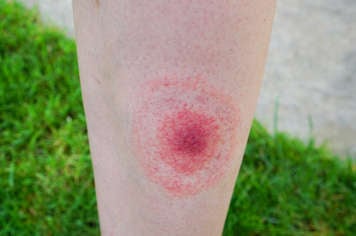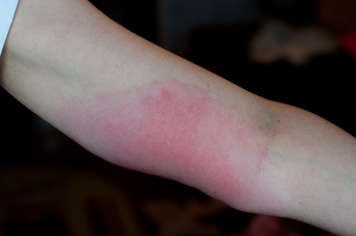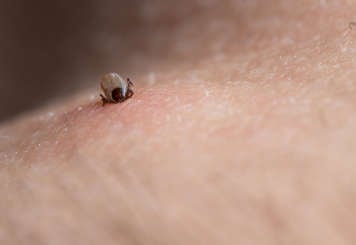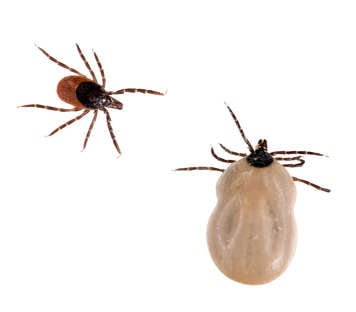What is Lyme disease?
Lyme disease is a bacterial infection transmitted by the blacklegged tick, also known as the deer tick. The infection is caused by the bacterium Borrelia burgdorferi, which is spread through tick bites.
When Lyme disease is treated early with the right medications, most children recover completely. However, if it is undiagnosed or left untreated, Lyme disease can lead to recurring or long-term health problems.
Signs and symptoms of Lyme disease
Symptoms of Lyme disease may occur in three stages. Not all children infected by Lyme disease go through these stages.
Stage 1 Lyme disease (early localized disease)
The most common sign of infection is a circular rash (erythema migrans) at the site of the tick bite. The rash can appear from three to 30 days, most commonly seven to 14 days, after a tick bite. When the rash starts, it is usually flat, but it can sometimes be slightly raised. The rash is usually, but not always, painless and not itchy. Over time, the redness becomes wider, typically measuring more than 5 cm across. It may look like a bull's eye, with a red ring surrounding a clear area and a red centre.


The rash usually fades after three to four weeks. It is often accompanied by the following symptoms:
- fatigue
- chills
- fever
- headache
- muscle and joint pain
- swollen lymph nodes
Stage 2 Lyme disease (early disseminated disease)
Left untreated, Lyme disease can spread in the body over the following days and weeks and progress to a second stage. The symptoms of stage 2 Lyme disease may include:
- fever
- headache
- weakness or drooping of one or both sides of the face
- neck stiffness
- multiple skin rashes
- arthritis and joint pain
- fast heartbeat and other heart rhythm problems
- extreme fatigue and general weakness.
Stage 3 Lyme disease (late disseminated disease)
If Lyme disease is still left untreated, it can progress to the third stage over the following months or years. The symptoms of stage 3 Lyme disease can last for months or years and may include:
- arthritis of one or more joints
- neurological problems such as:
- numbness
- weakness of the arms and legs
- encephalitis (rare)
Children who are treated with antibiotics in the first or second stage of Lyme disease almost never develop third-stage disease.
Risk factors for Lyme disease
If your child plays in a tick-infested forest or in grassy fields, they will be at a greater risk for tick bites. Since ticks attach easily to bare skin, having exposed skin is also a risk factor.
How ticks spread Lyme disease
The bacterium that causes Lyme disease is usually carried in squirrels, mice, birds and other small animals. Blacklegged ticks (deer ticks) spread Lyme disease to humans by feeding on infected animals and then feeding on people.
How to identify a blacklegged tick
Blacklegged ticks are usually red or dark brown and can be 3 to 5 mm (1/8 to 1/4 inch) long. After feeding on an animal or human, the tick can swell to the size of a grape. To see more images of blacklegged ticks see Government of Ontario: Tick-borne diseases.


How ticks attach to a person
Ticks are usually found in forest, bushes and overgrown areas between the woods and open spaces. Ticks cannot jump or fly, they need to wait until someone brushes against them before they can transfer.
Ticks attach to a person by their mouth when that person's bare skin brushes up against long grasses or bushes or comes in contact with surfaces (such as animal fur) where ticks are already present.
Where blacklegged ticks are most common
In Canada, the western blacklegged tick can be found in British Columbia's lower mainland, on Vancouver Island and in British Columbia's Fraser Valley. The blacklegged tick has been found in southern and eastern Ontario, southeastern Manitoba and parts of Nova Scotia. Because the tick may be carried on migrating birds, it can rarely also be found in other locations.
How Lyme disease is diagnosed
Lyme disease is not always easy to diagnose because its symptoms can resemble those of other diseases. In addition, not everyone who gets a tick bite develops a rash.
People who have clear symptoms of early localized disease, such as erythema migrans, and a history of potential tick exposure should be clinically diagnosed with Lyme disease. They should be treated without confirmation from laboratory tests. It often takes up to four weeks before a blood test will detect antibodies against the bacteria.
If your child has other symptoms of Lyme disease, your child's primary health-care provider will evaluate their symptoms and may order a blood test if they suspect Lyme disease. Most people with Stage 2 or Stage 3 Lyme disease will have antibodies in their blood against the bacterium.
Treatment of Lyme disease
If you find a blacklegged tick on your child and it has been attached for 24 hours or more, then your child should be seen by their primary health-care provider or a pharmacist, who can prescribe antibiotics to prevent infection.
It is important to treat Lyme disease early to prevent the later stages of the disease from developing. If your child is diagnosed with Lyme disease, their primary health-care provider will prescribe antibiotics. While most children will receive a two-week course of antibiotics, the length of treatment may be longer for children with arthritis, heart involvement or neurologic symptoms.
Preventing Lyme disease
If your child plans to play in tick-infested grasses or fields, there are some ways that you can reduce their exposure to ticks. Your child should:
- apply insect repellent on exposed skin
- wear long pants, closed-toe shoes (no sandals) and socks to protect bare skin from ticks
- wear clothing treated with insecticide
You should check your child for ticks on their clothing and skin after playing or hiking in tick-infested areas. If a tick attaches to your child's skin, it is important to remove the tick as soon as possible. Removing ticks with tweezers within 24 to 36 hours usually prevents infection.
If you find a tick on your child's skin, carefully remove it with tweezers. Do not squash or crush the tick while it is attached to the skin. You can save the tick in a plastic bag to show to your primary health-care provider later.
Information on tick removal can be found at Caring for Kids: Lyme disease.
Be careful with DEET insect repellent
DEET-based insect repellents work very well against ticks. If the instructions on the DEET-based insect repellant with regards to age of use and timing of reapplication are followed then DEET can be safely used on children.
Complications of Lyme disease
Lyme disease in pregnant women has been associated with stillbirths.
Canadian Paediatric Society (May 27, 2021). Lyme disease in Canada: Focus on children. https://cps.ca/en/documents/position/lyme-disease-children
Caring for Kids (September 2020). Lyme disease. https://caringforkids.cps.ca/handouts/health-conditions-and-treatments/lyme_disease
Health Canada (September 9, 2024). Lyme disease in Canada: For health professionals. https://www.canada.ca/en/public-health/services/diseases/lyme-disease/health-professionals-lyme-disease.html
Public Health Ontario (May 3, 2024). Lyme disease. https://www.publichealthontario.ca/en/Diseases-and-Conditions/Infectious-Diseases/Vector-Borne-Zoonotic-Diseases/Lyme-disease
